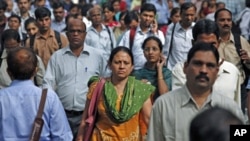As the world hits the 7 billion population mark, much attention is focused on India, which will surpass China to become the world’s most populous country in less than two decades.
The population growth will mean a nation full of working-age youth, which economists say could allow the already booming economy to maintain momentum. But educating this next generation, keeping it healthy and employed also could be a steep challenge.
Thirty-year-old Ravinder Pande works as a chauffeur for a businessman in New Delhi earning $200 a month. He has migrated to the Indian capital from neighboring Uttar Pradesh state, which the United Nations believes will be home to the world’s 7 billionth baby, born on October 31st.
Pande said he made virtually no money working on the small farm he owned and could not find any other work close to his village.
Need for skilled manpower
With nearly 200 million people, Uttar Pradesh is one of India’s most crowded and impoverished states, with few industries.
Fortunately for Pande, an economy racing ahead at about eight percent is creating new jobs in emerging hubs like Delhi, Mumbai and Bangalore.
Chandrajit Banerjee heads the Confederation of Indian Industry.
“There will be a demand for skilled manpower in every level, starting from a white collar right down to whatever you need, be it a carpenter to an auto mechanic to a driver… you have a whole range of requirements that are coming up and shall come up over a period of time,” said Banerjee.
These jobs are critically needed in a country expected to hit the one-and-half-billion mark around 2025. It will be one of the world’s youngest countries. By the end of the decade the average age of an Indian will be 29. This “youth bulge” will last until 2050.
Services versus manufacturing
Economists say this is a chance for India to reap what is called a “demographic dividend” - an opportunity to harness the skills and talents of young people in a growing economy at a time when most countries have aging populations.
However there are huge concerns. Economists say current rates of growth, although high, may not create enough jobs. The country will add a staggering 10 million people to the workforce every year, in the next two decades.
Well known Indian author and columnist Gurcharan Das said the farming sector, where two thirds of the country works, is in a state of decline and earnings are meager.
The services sector, led by information technology, is fueling India’s boom, but not adding jobs on the scale that is needed.
“What is concerning is that our economy is fired by services, not manufacturing. At least it is not the low-tech labor intensive manufacturing, which creates lots and lots of jobs, for example as China is doing or other counties in Eastern and South East Asia have done. Our real challenge is to creating a manufacturing and industrial revolution. We need to create far more jobs and you cannot expect services alone to do that,” said Das.
Other key challenges lie ahead. The public education system is not only failing to keep pace with surging demand, but is often of poor quality. This has led to fears that much of this young workforce will not gain the skills needed to power the economy.
For example, chauffeur Pande said he wants his two children to acquire skills that will help them do better jobs than driving. But he has left them behind in the village because he cannot afford housing for his family in the city.
Pande is not optimistic about how they will fare in the village. He said teachers often do not take classes in the village school. He is unsure if they will achieve success in their studies or get opportunity to tap their talents.
Cultivating vocational skills
The Confederation of Indian Industry, with the government, is expanding programs to give vocational skills to young people. But the Confederation’s head, Banerjee, said the need is huge.
“If you are unable to train with targets of like 500 million people, which the prime minister talked about, if you are not able to achieve that, all of this would be unemployed youth because they are unemployable in terms of today’s standards. And that can become a disaster and it could even have a huge negative social impact… so we have no choice but to focus on skilling,” said Banerjee.
A 2008 report by the Boston Consulting Group has warned that failure to make India’s young people productive will mean that the country will have an army of young people left behind.
The other big concern is health care. In Pande’s home state, Uttar Pradesh, infant mortality and malnutrition rates are high. It is not the only region that faces this problem. Nearly half of India’s children under five are malnourished. The school dropout rate also is high.
Sarah Crowe, spokesperson for the United Nations Children's Fund in New Delhi warns that these twin problems “could keep India back.”
“That child is unable to really grow to its ability and will remain in a state of stunting, and not be able to learn when it goes to school, and indeed later earn and really pay back into the economy, and help the country and region move forward," said Crowe. "Out of 200 million children who start school, only 10 percent complete grade 12, so that again means that potential is not being fully met.”
Policymakers admit the clock is ticking away. Others warn that India needs to step up investments in health care and education to ensure that its demographic dividend does not turn into what some call a demographic liability.





